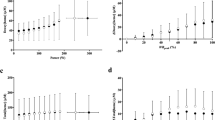Abstract
Purpose
We evaluated muscle proton elimination following similar exercise in the same muscle group following two exercise modalities.
Methods
Seven rowers performed handgrip or rowing exercise for ~ 5 min. The intracellular response of the wrist flexor muscles was evaluated by 31P nuclear magnetic resonance spectroscopy, while arterial and venous forearm blood was collected.
Results
Rowing and handgrip reduced intracellular pH to 6.3 ± 0.2 and 6.5 ± 0.1, arterial pH to 7.09 ± 0.03 and 7.40 ± 0.03 and venous pH to 6.95 ± 0.06 and 7.20 ± 0.04 (P < 0.05), respectively. Arterial and venous lactate increased to 17.5 ± 1.6 and 20.0 ± 1.6 mM after rowing while only to 2.6 ± 0.8 and 6.8 ± 0.8 mM after handgrip exercise. Arterio-venous concentration difference of bicarbonate and phosphocreatine recovery kinetics (T50% rowing 1.5 ± 0.7 min; handgrip 1.4 ± 1.0 min) was similar following the two exercise modalities. Yet, intramuscular pH recovery in the forearm flexor muscles was 3.5-fold slower after rowing than after handgrip exercise (T50% rowing of 2 ± 0.1 vs. 7 ± 0.3 min for handgrip).
Conclusion
Rowing delays intracellular-pH recovery compared with handgrip exercise most likely because rowing, as opposed to handgrip exercise, increases systemic lactate concentration. Thus the intra-to-extra-cellular lactate gradient is small after rowing. Since this lactate gradient is the main driving force for intracellular lactate removal in muscle and, since pHi normalization is closely related to intracellular lactate removal, rowing results in a slower pHi recovery compared to handgrip exercise.




Similar content being viewed by others
Abbreviations
- ANOVA:
-
Analysis of variance
- pHi :
-
Intracellular pH
- 31PMRS:
-
Phosphorus-31 nuclear magnetic resonance spectroscopy
- PCr:
-
Phosphocreatine
- MVC:
-
Maximal voluntary contraction
References
Bangsbo J, Johansen L, Graham T, Saltin B (1993) Lactate and H+ effluxes from human skeletal muscles during intense, dynamic exercise. J Physiol 462:115–133
Boushel R, Pott F, Madsen P, Rådegran G, Nowak M, Quistorff B, Secher NH (1998) Muscle metabolism from near infrared spectroscopy during rhythmic handgrip in humans. Eur J Appl Physiol Occup Physiol 79:41–48
Hoch JC, Stern SS (1996) NMR data processing. Wiley, Hoboken
Juel C (1997) Lactate-proton co-transport in skeletal muscle. Physiol Rev 77:321–358
Kemp GJ, Taylor DJ, Styles P, Radda GK (1993) The production, buffering and efflux of protons in human skeletal muscle during exercise and recovery. NMR Biomed 6:73–83
Kemp GJ, Thompson CH, Sanderson AL, Radda GK (1994) pH control in rat skeletal muscle during exercise, recovery from exercise and acute respiratory acidosis. Magn Reson Med 31:103–109
Kemp GJ, Thompson CH, Taylor DJ, Radda GK (1997) Proton efflux in human skeletal muscle during recovery from exercise. Eur J Appl Physiol Occup Physiol 76:462–471
Lawson JWR, Veech RL (1979) Effects of pH and free magnesium on the Keq of the creatine kinase reaction and other phosphate hydrolyses and phosphate transfer reactions. J Biol Chem 254:6528–6537
Mizuno M, Secher NH, Quistorff B (1994a) 31P-NMR spectroscopy, rsEMG, and histochemical fiber types of human wrist flexor muscles. J Appl Physiol 76:531–538
Mizuno M, Horn A, Secher NH, Quistorff B (1994b) Exercise-induced 31P-NMR metabolic response of human wrist flexor muscles during partial neuromuscular blockade. Am J Physiol 267:R408–R414
Nielsen HB (1999) pH after competitive rowing: the lower physiological range? Acta Physiol Scand 165:113–114
Nielsen HB, Hein L, Svendsen LB, Secher NH, Quistorff B (2002) Bicarbonate attenuates intracellular acidosis. Acta Anaesth Scand 46:579–584
Rasmussen J, Hanel B, Diamant B, Secher NH (1991) Muscle mass effect on arterial desaturation after maximal exercise. Med Sci Sports Exerc 23:1349–1352
Ratkevicius A, Quistorff B (2002) Metabolic costs of force generation for constant-frequency and catchlike-inducing electrical stimulation in human tibialis anterior muscle. Muscle Nerve 25:419–426
Volianitis S, Secher NH, Quistorff B (2010) The intracellular to extracellular proton gradient following maximal whole body exercise and its implication for anaerobic energy production. Eur J Appl Physiol 109:1171–1177
Acknowledgements
We thank Ib Terkelsen and Frederik Secher for valuable assistance during data collection.
Author information
Authors and Affiliations
Contributions
BQ contributed the hypothesis of the study. All authors contributed to the design of the study, collection, assembly and interpretation of data. All authors contributed to manuscript writing and approved the final version of the manuscript.
Corresponding authors
Ethics declarations
Ethical approval
All procedures performed were in accordance with the ethical standards of the University of Copenhagen and Ethical Committee of Copenhagen (H-3-2011-097) and with the 1964 Helsinki declaration and its later amendments or comparable ethical standards.
Additional information
Communicated by Phillip D. Chilibeck.
Rights and permissions
About this article
Cite this article
Volianitis, S., Secher, N.H. & Quistorff, B. Elevated arterial lactate delays recovery of intracellular muscle pH after exercise. Eur J Appl Physiol 118, 2429–2434 (2018). https://doi.org/10.1007/s00421-018-3969-x
Received:
Accepted:
Published:
Issue Date:
DOI: https://doi.org/10.1007/s00421-018-3969-x




